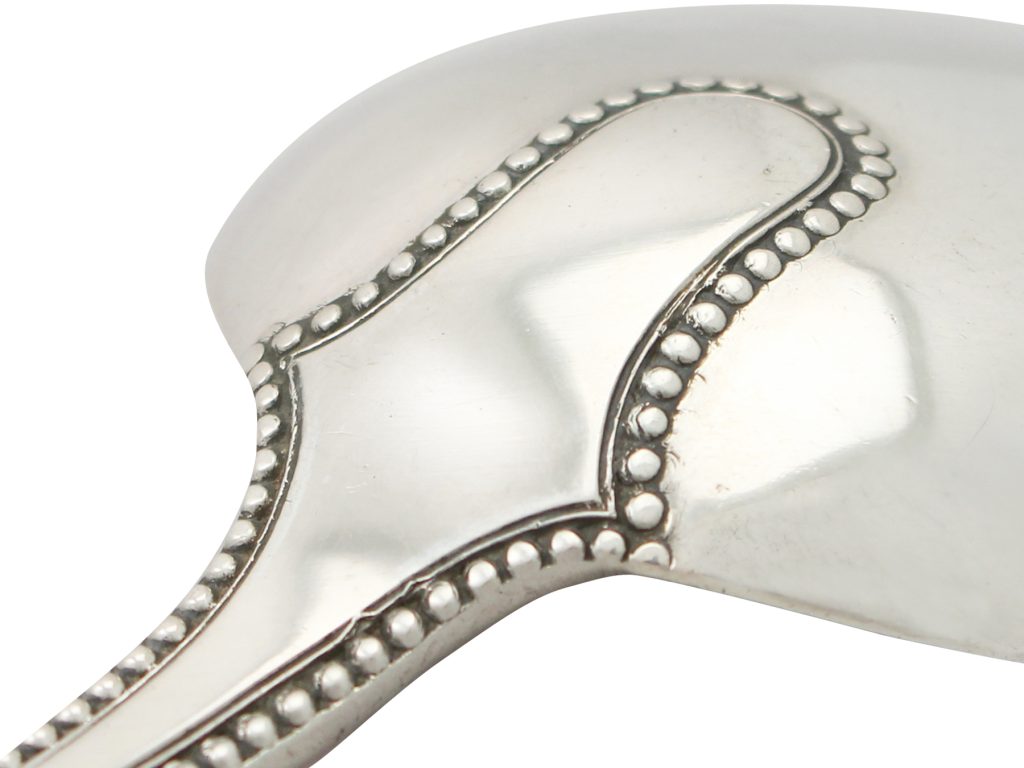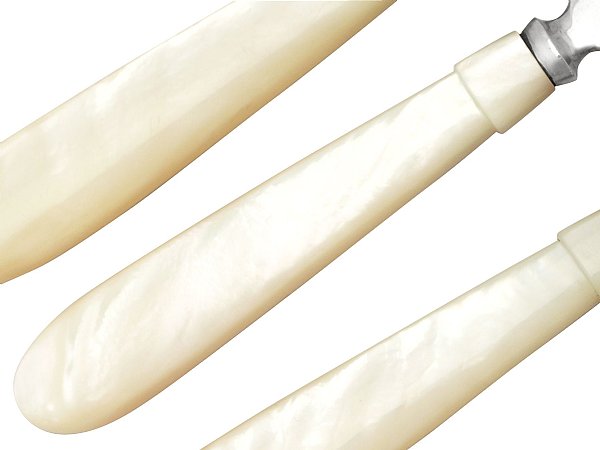Here at AC Silver we pride ourselves in the range of variations of holloware and flatware available for sale. The expansive style differences can sometimes cause a simple shopping experience to have more design options than our customers expect, but have no fear, the shop staff are on hand to help guide you through the options until the treasure is found.
On the phone we are frequently asked about the canteens of cutlery available, with a particular preference for a certain silver flatware pattern or maker. The learning curve starts when customers merely wish to know how to start the hunting process and do not fully understand the differences between each service based on a pattern style or even the included components.
This is a complex decision to make, but when it comes to finding the perfect flatware pattern the first question you need to ask yourself do you prefer plain or more decorative designs, and go from there:
Plain
Dog Nose Pattern
- Wavy ended terminal
- Handle terminals for both spoons and forks turn up
- Forks traditionally have 3 prongs (tines)
- Knives are typically cannon or pistol handled
This silverware pattern was typical for the dining table during the reign of Queen Anne, with most services being crafted from the late 1690s to the circa 1715. This pattern creates a transition between the Trefid and the Hanoverian patterns, as the terminal of the handle removes the former pattern’s notches. If each piece were to bear a crest it would be engraved the reverse surface, as it was still common practice to lay each component in the French manner (bowls and tines facing down). The 19th century examples classical bear a plain bowl, however the early examples incorporate a rat tail to the back of the bowl, often featuring ribbed or bead decoration.
Hanoverian Pattern
- Plain rounded handle
- Handle terminals for both spoons and forks turn up
- Forks have 3 or 4 prongs


This silver flatware pattern evolved around 1710 from the late 17th century Trefid/Dog Nose pattern which preceded it; a style with had a tri-lobed terminal. This new Hanoverian pattern saw the handle terminal rounded off, separating the design characteristics. Hanoverian pattern is appropriately named due to its manufacture spanning the majority of the 18th century during the reign of the House of Hanover Dynasty (George I, II and III). This service also bears crests to the reverse service due to being placed on the table in the French manner. As the development of the pattern continued, design saw a diminished central ridge the anterior surface resulting in a pip to the handle terminal in addition to a more egg shaped bowl to each spoon.
Old English Pattern
- Plain rounded handle
- Handle terminals for spoons turn down and forks turn up
- Forks traditionally have 4 prongs (tines)


In the 1750s, when the upturned Hanoverian serving implements were seen to be awkward to use, the Old English pattern subtly changed the rules and determined the end of the spoons were to turn down not up. The forks were not developed in the same manner for ease of handling, but this meant the engraving of a crest to a fork would remain on the underside whereas it changed to the anterior surface for each spoon.
Fiddle Pattern
- Plain handle shaped like the body of a violin (or fiddle) to a slim stem
- Pronounced shoulders
- Handle terminals for spoons turn down and forks turn up
- Forks traditionally have 4 prongs (tines)
The 19th Century saw the uprising of the Fiddle pattern, another plain pattern available without the distinguishable shoulders and given an alternative name of Oar pattern. This pattern originated in France where both the fork and the spoon terminals turned up, whereas in England the forks and spoons were manufactured to reflect the positive and successful changes implemented with the Old English pattern.
Now for the Plain Twist
The details laid out above are for the standard silver flatware patterns, but there are variations on these enabling a plain handle to become more decorative. Now you know the popular base names (Hanoverian, Fiddle, King’s etc.) you will note that on some items of flatware there are additional words added to the pattern name. Here are some of the most common examples:
Rat Tail
A long rat-tail like ridge found to the reverse of the bowls/base of the tines in Hanoverian pattern flatware; this is a continuation of the development from Trefid/Dog Nose as they too could be found with a Rat Tail. This detailing helped determine the location of the hallmarks from the bowls to the stems/terminals.

Thread
This border consists of one or two thin closely spaced lines along the stem and around the handle terminal, incorporating the pip. The anterior surface of each spoon stem and handle is encompassed with thread decoration and embellished to the terminal with a contemporary bright cut engraved crest of a demi lion rampant:
Shell
A shell ornamentation to the terminal of the handle, either one side or both. These examples are both Fiddle and Shell pattern but this is also a common design to be incorporated on Old English and Hanoverian pattern:
Thread and Shell
The pattern is in the name, it joins together the paralleling thread pattern border and the shell design to the terminal:
Bead
A simple border of bead decoration following the shape of the handle, and in the Old English Bead example shown here, the ornamentation continues around the heel to the back of the bowl:
Feather-Edge
A paralleling border to the shape of the handle embellished with engraved diagonal lines representing a simplified feather texture:
Decorative
Onslow Pattern
- Cast tapering volute scrolling terminal to a slim stem
- The terminal joins the stem by a scarf joint
This pattern was a strange occurrence for its time, the 1760s brought about the development of the Hanoverian pattern and this more creative pattern is presumed to be used alongside it. This handle design was limited to serving pieces as the tapering terminal made each item slightly more awkward to use.
Albany Pattern
- Tapering fan shaped handle terminal
- Fluted decoration with a ball design on the terminal
- Also known as Queen Anne pattern

This Mid-late 19th century design is a variant of the Onslow pattern. Due to the down turned handle being an inconvenience during use, this straight handled channelled alternative was developed.
Lily Pattern
- Lobed naturalistic enveloped leaf handle
Unlike designs before it, this mid-late 19th century silver flatware pattern was crafted to cater to the more eclectic of tastes. Many established companies made their own pattern books, and although several of the late Victorian patterns/names are no longer generally used, ones such as the Lily pattern have become highly collectable and popular today due to its diverse flowing beauty.
King’s Shape
There are many patterns that can be placed in this category, but there are three main patterns crafted in this early 19th century style. Each piece has a ‘King’s shape’ handle consisting of a waisted lobed terminal adorned with a distinguishing feature.
King’s Pattern
- Notable feature/device: honeysuckle
- Shell design to anterior surface of handle terminal is concave
- Shell design to posterior surface of handle terminal is convex
Queen’s Pattern
- Notable feature/device: flower head and honeysuckle
- Shell design to both anterior and posterior surfaces of handle terminal are convex
- Also known as Rosette pattern
- This is the most decorative of the three principle King’s shape patterns
Hourglass Pattern
- Notable feature/device: hourglass
- Shell design to anterior surface of handle terminal is concave
- Shell design to posterior surface of handle terminal is convex
- This is the simplest style of the three patterns
The 20th Century
By the time the 20th century came about is there any surprise that the iconic styles around the world were reflected in everything, including flatware. The silver flatware development was to encourage the up and down turned handles to become straight and the style of the three pronged fork from the late 17th century was revived. The Art Deco period saw the re-popularisation of the plain tapering handles accented with simplistic designs, taking advantage of all angles and the pattern books became full with the era’s fashions and passions.
The Foundation is Laid, Now to Build
So there we have it, using the basics of the silver flatware patterns the complexity of the desired service can be determined. The outline has mainly been on handles, and the next question is how do you want the heel to look? But I feel that may be a question for another day.
Have we spiked your interest for a new collection of cutlery? If so take a look online at our ranges, give us a call and we will be thrilled to help you start your journey.























3 Responses
Hello Rachel,
Very interesting.
I first became interested in cutlery
when my mother
began expanding the family fiddle and thread
to build a service for 36,
visiting antique shops and jewellers
for her.
My reason for replying
is that I collect cutlery,
have never found a glossary
of cutlery design terms,
and note your use
of the words ‘stem’ and ‘terminal’.
I am starting a cutlery blog,
and wish
to describe my cutlery collection better!
Can you point me in the right direction,
please?
Zen
Lovely and informative website
Thank you
Glad you like the website Carole.